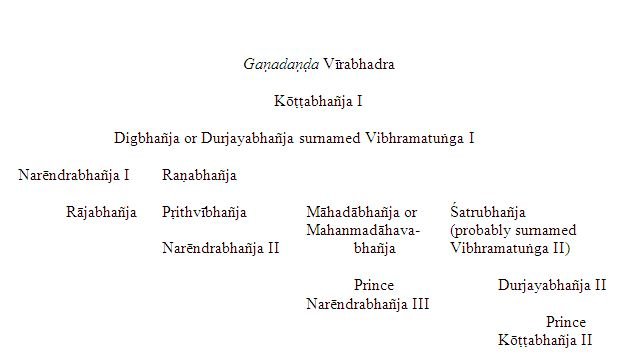|
EPIGRAPHIA INDICA
issued the Jamdapir (Bamanghati) plate (No. 2),[1] Śatrubhanja who issued the Kesari Plate[2] and
Māhadābhañja or Mahanmadāhavabhañja of the Khiching charter under discussion. The order
of succession amongst these sons of Raṇabhañja, who claim to have been residents of Khijjiṅgakōṭṭa (with the exception of Śatrubhañja who may have ruled a part of his father’s kingdom
side by side with one or more of his brothers), cannot be determined. In the Khandadeuli plate[3] of
Narēndrabhañja, his father Pṛithvībhañja seems to be described as the aupāyika son of Raṇabhañja.
This may suggest that Pṛithvībhañja claimed to be an adopted son of Raṇabhañja. The
Kesari plate, which does not strictly follow the draft of the Ādi-Bhañja records discussed above
and may be later than the records of the other sons of Raṇabhañja, describes Śatrubhañja as
the son of Raṇabhañja, grandson of Durjayabhañja and great-grandson of Kōṭṭabhañja.
It seems that Durjayabhañja was another name of Digbhañja-Vibhramatuṅga.[4] This record
also speaks of the queen Anakaḥdēvī and the crown-prince Narēndrabhañja who may have been
a son of Śatrubhañja. The only other known inscription of the Ādi-Bhañja family is the Adipur
plate (No. 3)[5] of Durjayabhañja who was a son of Vibhramatuṅga and grandson of Raṇabhaṅja.
The genuineness of this grant has been doubted and it has been assigned to the fifteenth century.
It is, however, not improbable that the record actually belongs to a grandson of Raṇabhañja.
This supposition would suggest that Raṇabhañja had, besides Rājabhañja, Pṛithvībhañja, Mahanmadāhavabhañja and Śatrubhañja, another son named Vibhramatuṅga, or that Vibhramatuṅga
was the biruda of one of the known sons of Raṇabhañja. Now this record mentions the queen
Chihipamahādēvī and the crown-prince Kōṭṭabhañja who may have been a son of the reigning
monarch. The style of mentioning the queen and the crown-prince connects the record with the
Kesari plate. The name of king Durjayabhañja also reminds us of the fact that the Kesari
plate alone mentions Digbhañja-Vibhramatuṅga under this name. It thus seems possible to suggest
that, amongst the sons of Raṇabhañja, it was Śatrubhañja who had the biruda Vibhramatuṅga
and was the father of Durjayabhañja of the Adipur plate (No. 3). But whether Narēndrabhañja,
son of Śatrubhañja, was the same as Durjayabhañja cannot be determined. The above discussion
on the genealogy of the Ādibhañjas may thus be summarised in a tabular form as follows :

___________________________________________________
[1] Archaeological Survey of Mayurbhanj, Vol. I, pp. 144 ff. It is not possible to take Rājabhañja as a son of
Digbhañja (cf. Bhandarkar’s List, No. 1489 and p. 379).
[2] Above, Vol. XXV, pp. 162 ff.
[3] JBORS, Vol. IV, pp. 175 ff.
[4] Above, Vol. XXV, p. 151.
[5] Ibid., p. 173.
|